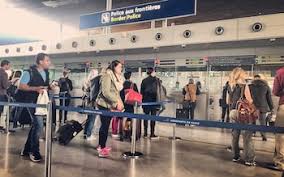Introduction to the Air Traffic Control Strike.
The wonder of air travel, which enables us to cover great distances in a matter of hours, can quickly turn into chaos when Air Traffic Control goes on strike. A recent walkout by controllers caused unexpected disruptions for thousands of flights across the country. As a result, passengers were either stranded at airports or frantically trying to make alternate plans, while airlines struggled to handle the turmoil.
As travelers watched in shock, industry experts shared their opinions on the implications for aviation and safety regulations going forward. Let’s examine the factors behind this unprecedented air traffic control strike and its effects on flights across the country. Whether you’re a seasoned traveler or preparing for your next trip, being aware of these developments can assist with navigating through uncertain circumstances in the future.
Causes of the Air Traffic Control Strike.
The recent Air Traffic Control Strike is the result of a combination of long-standing issues. Numerous air traffic controllers have expressed their frustration with low wages as a major problem. Despite their vital responsibility in maintaining flight safety, their pay has not kept up with the increasing cost of living. Moreover, the industry faces compounded frustrations due to staffing shortages. The excessive workload and stretched resources experienced by controllers often result in burnout and decreased job fulfillment. This shortage of adequate personnel further compounds operational setbacks.
The state of the workplace is also a major factor in the turmoil. Employees are constantly under intense pressure, requiring them to maintain extreme concentration and accuracy; nevertheless, several individuals believe that they do not receive sufficient assistance. In addition, the talks surrounding contracts have been at a standstill for quite some time. The unresolved matters concerning work-life balance and retirement benefits only add to the dissatisfaction among these vital employees.
Impact on Air Travel.
The recent Air Traffic Control strike has sent shockwaves through the aviation industry. Flights across the nation experienced significant disruptions, leaving travelers stranded and anxious. Delays became the norm as airlines scrambled to manage their schedules amidst a shortage of air traffic controllers.
Airports affected by the air traffic control strike saw long lines at check-in counters and gate areas filled with frustrated passengers. Many flights were canceled outright, while others faced extended wait times due to rerouted air traffic.
With communication between pilots and ground crews disrupted, safety protocols took precedence. Travelers found themselves facing uncertainty regarding their intended destinations and connecting flights.
This unprecedented situation highlighted vulnerabilities in our national air travel system, raising concerns about future contingency plans for similar events. The ripple effects are likely to be felt for days, if not weeks, as airlines work diligently to restore normalcy in operations.
Affected Airlines and Airports due to Air Traffic Control Strike.
The Air Traffic Control Strike caused considerable disruptions for multiple airlines. Major carriers including Delta, American Airlines, and United all experienced widespread cancellations and delays, resulting in stranded passengers at airports throughout the country. Major airports faced severe impacts, especially hubs like Atlanta’s Hartsfield-Jackson, Chicago O’Hare, and Los Angeles International. This resulted in a domino effect of disarray as long queues formed due to the uncertainty surrounding travelers’ inquiries.
The effects were also felt by regional airlines. Their smaller counterparts faced difficulties in adhering to their schedules due to disruptions in air traffic. The strike had a widespread impact, causing difficulties for both flights and ground operations. Baggage handling and passenger services were particularly overwhelmed as crews worked to navigate unforeseen circumstances. In light of the changing situation, travelers had to swiftly adjust and stay informed through updates from both airlines and airport authorities.
Reactions from Passengers and Industry Experts.
Throughout the unfolding of the strike, passengers displayed a range of emotions including frustration and concern. Numerous individuals turned to social media to share their experiences of flight cancellations and lengthy wait times at airports. The air traffic controllers’ walkout brought about uncertainty, leaving travelers feeling anxious about reaching their intended destinations.
Industry professionals offered differing viewpoints. While some claimed that immediate action was necessary to improve working conditions for air traffic controllers, others emphasized the role of insufficient funding in exacerbating tensions among employees. Amidst the disruptions, concerns were raised about safety by some, who stressed that an extended strike could add strain to an already fragile aviation system. In response to the chaos, airlines rushed to accommodate passengers and redirect flights, resulting in additional delays and confusion.
The event had a ripple effect on the entire travel industry, prompting discussions about necessary changes in the future. This was evident as travel agencies worked to support clients impacted by unexpected cancellations or itinerary changes.
Steps Taken by Authorities to Resolve the Situation.
In response to the air traffic control strike, authorities promptly took action. Meetings were organized between federal and state officials to discuss how to quickly restore normal operations. Interim solutions involved adding extra personnel from other areas of aviation. Skilled controllers from nearby zones were brought in to aid overloaded facilities.
Efforts were made to swiftly pass laws that would enhance the working conditions of air traffic controllers. The goal was not only to address present problems, but also to proactively avoid any potential strikes in the future. Ensuring transparency during this turbulent time, updates on flight statuses and guidelines for affected travelers flooded social media platforms and news outlets, making public communication a top priority. In their collaboration with regulators, airlines worked closely to explore alternatives such as redirecting flights or modifying schedules when possible. These endeavors demonstrated a pressing need to reduce inconvenience for passengers while upholding safety standards in all areas.
Conclusion: Lessons Learned and Future Precautions.
The recent strike by air traffic controllers highlighted the vulnerabilities in our aviation system. With numerous flight cancellations and delays, it was evident that air traffic controllers play a crucial role in keeping the skies organized. Moving forward, it is crucial for both industry players and government officials to enhance communication methods. This can aid in avoiding future strikes that disrupt travel arrangements across the country. In addition, advancements in technology could contribute by facilitating better management during peak periods or unforeseen incidents.

Teaching passengers about potential disturbances is also a crucial measure. Passengers must remain updated on flight statuses and familiarize themselves with backup plans in the event of an air traffic control issue. Adjusting to this ordeal has the potential to result in stronger systems and more seamless procedures as we navigate the intricacies of contemporary air travel.






